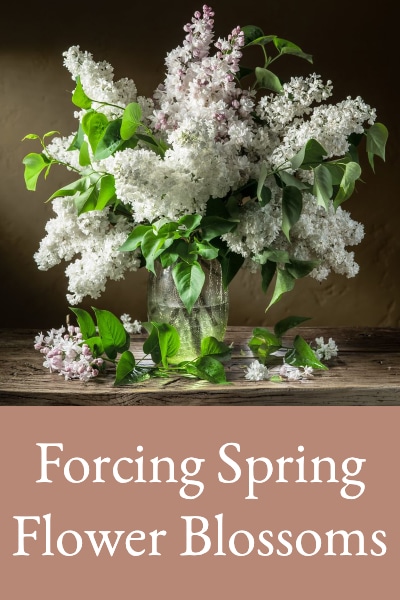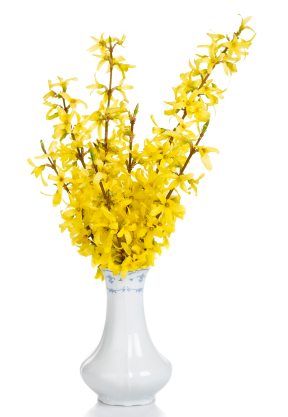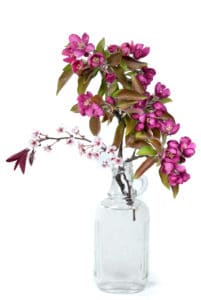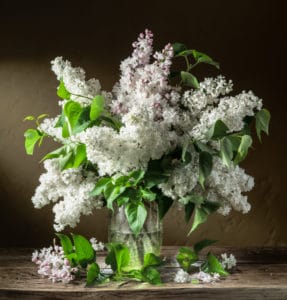
In the colder areas of the US, it’s been a long winter, and we’re more than ready for some pretty flowers!
So, it’s a great time to start pruning spring-blooming trees and shrubs; and forcing the branches to bloom indoors for some spring blossoms.
Benefits of Forcing Spring Flowers
The obvious benefits of forcing spring flowers are the color, scent, and texture of beautiful blooms indoors.
The not-so-obvious benefit is that you are doing the necessary pruning of these trees and shrubs while the plants are dormant. That means you can clearly see their shape and form as you prune (see HERE for tips on how to properly prune).
Trees and Shrubs Good for Forcing Spring Flowers
Anyone living where trees and shrubs go through a dormant winter chill (typically eight weeks) can force indoor blooms and almost anything that blooms in spring can be forced.
Trees and shrubs that bloom in spring, form their flower buds the previous fall. After at least eight weeks of cold winter dormancy (under 40°F), their branches are capable of blooming indoors if you provide the right conditions.
Varieties to consider for forcing include (followed by approximate time to bloom indoors):
- Crab Apple (4 weeks)
- Flowering Cherry (4 weeks)
- Flowering Pear (4 weeks)
- Buckeye (5 weeks)
- Horse Chestnut (5 weeks)
- Eastern Redbud (2 weeks)
- Honeysuckle (3 weeks)
- Willow (2 weeks)
- Pussy Willow (2 weeks)
- Cornelian Cherry (2 weeks)
- Forsythia (1 week)
- Witch Hazel (1 week)
- Lilac (4 weeks)
- Magnolia (3 weeks)
- Spirea (4 weeks)
- Serviceberry (3 weeks)
- Quince (4 weeks)
- Red Maple (2 weeks)
- Wisteria (3 weeks)
- Dogwood (5 weeks)
Plants that naturally bloom the earliest will be the first (easiest) to force into bloom, but as time goes on, plants that bloom later in the season can also be forced successfully (they just need their minimum dormancy requirements met).

Forced Bloom Forsythia Bouquet
How to Prune Branches
Choose a day when temperatures are above freezing and take a pair of clean, sharp pruners along. I like to prune as each plant’s appearance and form dictates, as well as remove any crossed branches. Pick branches that aren’t essential to the bush or tree form and that have lots of flower buds (flower buds are typically rounder and fatter than leaf buds). Prune one to two-foot-long branches from your tree or shrub.
How to Force Spring Flowers
Then take the pruned branches indoors and re-cut them underwater. Cutting underwater prevents air bubbles from getting inside, and blocking water intake. After that, keep the stems submerged in cool water (a washtub or bathtub works) for several hours to hydrate them and soften the bud’s outer covering.

Crab Apple Bouquet
Waiting for Blooms
After soaking, put the branches in a bucket or vase (making sure to keep the stems submerged) in a cool area and wait for the buds to open. A ½ tsp. of chlorine bleach per quart of water should be used (to prevent mold from forming and blocking water intake) and the water should be changed every few days. How long it takes for blooms depends on the plant variety and the specific conditions inside.
Once the flower buds begin to show some color, the branches can be used in arrangements. Using a floral preservative (available at florists or garden centers) may increase the longevity of arrangements.

Forced Lilac Bouquet
Just experimenting is half the fun, so get out there with those pruning shears! And after you’ve got things looking and smelling beautiful indoors, check out how to create beautiful outdoor container plantings HERE.
Leave a Reply